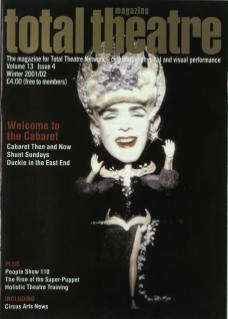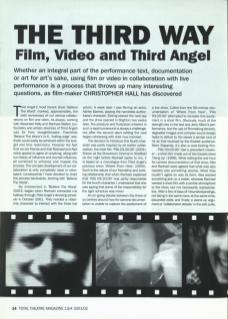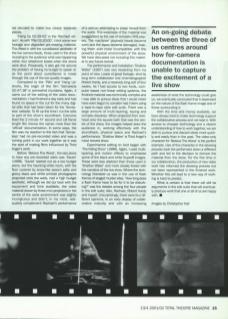Third Angel's most recent show Believe The Worst marked, approximately, the sixth anniversary of our various collaborations on film and video. As always, working with Alexander Kelly and Rachael Walton (co-founders and artistic directors of Third Angel) was far from straightforward. Thankfully Believe The Worst's lo-fi, 'trailing edge' aesthetic could easily be achieved within the budget and time restrictions. However the fact that we are friends and that Rachael and Alex rarely appear to agree on anything, along with our history of influence and counter-influence all combined to enhance and impede the process. The complex development of our collaboration is only completely clear in retrospect; consequently I have decided to chart the process backwards, starting with Believe The Worst.
My involvement in Believe The Worst (2001) began when Rachael contacted me halfway through Third Angel's devising schedule in October 2001. They needed a video only character to interact with the three live actors. A week later I was filming an actor, Ashley Barnes, playing the nameless authoritarian character. Editing started the next day and the show opened in Brighton two weeks later. The pressure and frustration inherent in such a rapid turnaround is always a challenge, but after the second day's editing the cast began rehearsing with their new member.
The decision to introduce this fourth character was partly inspired by an earlier collaboration, the short film Pills 03:20:00 (2001). Shown at the Showroom Cinema in Sheffield on the night before Rachael spoke to me, it is based on a monologue from Third Angel's previous show Where From Here (2000). Such is the nature of our friendship and working relationship that when Rachael explained that Pills 03:20:00 was partly responsible for the fourth character, I understood that she was saying that some of the responsibility for the tight schedule was mine!
An ongoing debate between the three of us centres around how for-camera documentation is unable to capture the excitement of a live show. Culled from the 90-minute documentation of Where From Here, Pills 03:20:00 attempted to recreate this excitement in a short film. Obviously, much of the strength lies in the text and Jerry Killick's performance, but the use of filmmaking devices, degraded images and complex sound design helps to deliver to the viewer a similar kind of hit as that received by the theatre audience. More flippantly, it's also a cool-looking film.
Pills 03:20:00 had a precedent however – a short film made out of the theatre show Hang Up (1999). While editing the one-hour for-camera documentation of that show, Alex and Rachael were agreed that what was also needed was something shorter. What they couldn't agree on was its form. Alex wanted something akin to a trailer, whereas Rachael wanted a short film with a similar atmosphere to the show, but not necessarily representative. After a few days of misunderstandings, not being in the same room at the same time, discarded edits, and finally a stand-up argument or 'collaborative debate’ in the edit suite, we decided to make two clearly separate pieces.
An ongoing debate between the three of us centres around how for-camera documentation is unable to capture the excitement of a live show.
Hang Up 02:39:02 is the 'Rachael version'. As with Pills 03:20:00, I shot some new footage and degraded pre-existing material. This fitted in with the surveillance aesthetic of the live camera feeds, those used in the show revealing to the audience what was happening within four telephone boxes when the doors were shut. Prosaically, it also got me around the problem of having no budget to speak of, as the point about surveillance is made through the use of the low quality images.
Compared to the Pills and Hang Up shorts, the origin of the film Senseless 02:47:18 is somewhat mundane. Again, it came out of the editing of the video documentation. I had finished a day early and had found no space in the cut for the many digital stills that had been taken for the Senseless website. To fill up the time I cut the stills to part of the show's soundtrack. Everyone liked the 2 minute 47 second and 18 frame length film (hence the name) more than the 'official’ documentation. In some ways, the film was my reaction to the fact that Senseless had no pre-recorded video and was a turning point in our work together as it was the start of making films influenced by Third Angel's work.
Before Believe The Worst, the last piece to have any pre-recorded video was Saved (1998). Saved started out as a low budget piece, but the haunting white room, with the floor covered by snow-like epsom salts and grainy black and white pinhole photographs projected onto the walls, had a high budget aesthetic. Although we did our best with the equipment and time available, the video material shown by three mini-projectors in the centre of the eerie environment was slightly incongruous and didn't, in my mind, adequately complement Rachael's performance of a woman attempting to erase herself from the world. This weakness of the material was exaggerated by the use of domestic VHS players. The machines' playback heads became worn and the tapes became damaged, making them ever more incompatible with the powerful physical environment of the show. We have discussed not including this material in any future revival.
The performance and installation Shallow Water (1997) was very rewarding from my point of view. Loads of great footage, shot by long-term collaborator and cinematographer Robert Hardy, and a relatively long edit of four weeks. As I had access to two Avids, computer based non-linear editing systems, the finished material was technically complex and I was able to pursue ideas that I would never have even begun to consider had I been using a tape-to-tape style edit suite. There was a large amount of multi-layering, keying and complex dissolves. When projected from overhead onto the square bath that was the centre of the show, the images helped draw the audience in, working effectively with the soundtrack, physical space and Rachael's performance. Shallow Water is Third Angel's most revived show.
Experimental editing on Avid began with The Killing Show (1996). Again, I used multi-layering and motion effects to emphasise some of the black and white Super8 images. These were less abstract than those used in Shallow Water and more closely linked with the narrative of the live show. Where the technology liberated us was in the use of flash frames of staged murder sites. ‘How long does a flash frame have to be for it to be disturbing?' was the debate among the four people in the edit suite – Alex, Rachael, Robert Hardy and myself. Unsurprisingly, there were four different opinions. In an early display of collaborative maturity and with an increasing awareness of what the technology could give us, we eventually concluded that it depended on the nature of the flash frame image and of those surrounding it.
With the time and money available, we have always tried to make technology support the collaborative process and not lead it. With access to cheaper technology and a clearer understanding of how to work together, we are able to pursue and discard ideas more quickly and easily than in the past. The video-only character for Believe The Worst is the perfect example. Use of this character in the devising process took the performers down a different path and led to the decision to remove the material from the show. For the first time in our collaboration, the production of new video work has informed the devising process but not been represented in the finished work. Whether this will lead to a new way of working is hard to predict.
What is certain is that there will still be arguments in the edit suite that will eventually produce work that one or all of us are happy with.


